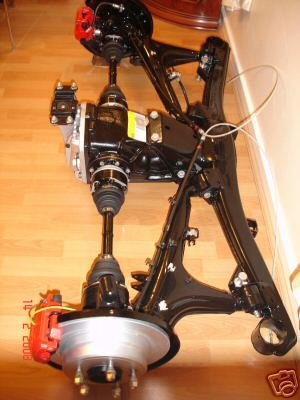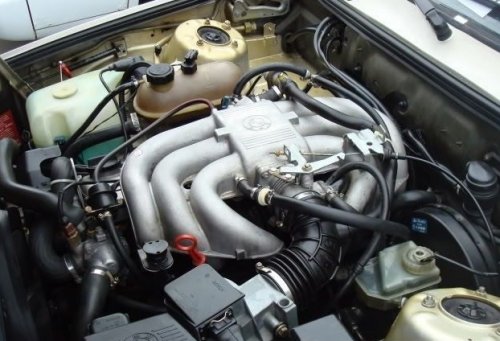E28 Home |
Models |
Interior |
Tourings |
Options |
Problems |
Gallery |
//M Car |
Tuners |
BMW E28 Five Series - Mechanicals
Engines
The 518i used the trusty and reliable M10, a 518 carb version was available in mainland europe. The 520i used the M20 six cylinder, early versions had Jetronic-K until 1984 when it was replaced by Jetronic-L. A 2.7 M20 was also used in the 525e / 528e eta. For 1988 US eta's had the 2.5i head giving a so called "super-eta" with a bit more power, this was due to the introduction of the E34 outside of the US and the cessation of eta head production.
The 525i, 528i, 533i and 535i shared the M30 six with the smaller versions using Jetronic-L and the 3.5 having more advanced Motronic injection. Around 1986 they changed to a smaller more encapsulated throttle position switch. US M30s had lower compression to cope with low octane fuel and make about 36bhp less as a result.
The M5 (but not the M30 M535i) had the S38 24 valve engine. There were always rumours that it was sold in a lower state of tune than was the case with the M635CSi but on paper both versions are the same.
Diesels used the M21 in either normally aspirated (1986 onwards) or turbo (1983 onwards) forms. From 1987 diesels had fly by wire throttles and Bosch DDE (Digital Diesel Electronics), at least they did on the early euro E34 version. I'd be interested to know about the final year US E28 diesels as DDE may only have been used on E34s.

E28 rear axle showing trailing arms and anti-roll bar.

E28 rear axle showing hubs and subframe.
Suspension
All E28s had the same basic suspension with Macpherson struts at the front and semi-trailing arms at the rear. At both ends the shocks are mounted inside the springs. Front and rear anti-roll bars were always standard.
The previous E12 system could be quite tail happy in the wet and was prone to breaking away under power or when weight transferred to the front whilst braking in a corner. The E28 rear subframe helped reduce this tendency but not eliminate it by any means, the main change was to adjust the trailing arm angle by 12 degrees.
Some M5s had self leveling suspension, this is overkill and in my view not required. If it gives any trouble replace it with normal springs and shocks.
Pitman arms, often called dog bones, are used to prevent side to side motion of the rear trailing arms. If your suspension wanders this may be a cheap and easy fix. The rear subframe is held to the body by a pair of large rubber bushings, these don't last forever and can be another cause of wandering.
Semi-trailing arm systems will have their geometry compromised by overly lowering the car, 25mm would be my limit. For cars with stiffer suspension a front strut brace isn't a bad idea.

Pitman arms prevent sideways trailing arm motion.
Steering
All E28s used power assisted worm and sector steering rather than rack and pinion. The steering box is mounted on the same side of the car as the steering wheel, the other side has an idler arm. A centre drag link joins the steering box arm and idler arm whilst tie rods connect the ends of the drag link to the wheel hubs. If the system has play in the centre it can sometimes be adjusted out, but normally a new steering is the only solution.
There are numerous bushings and bearings in this system and wear in any of them can cause problems, especially with wheels larger than 16" or wide tyres. The easiest way to check for play is to brake hard from speed and watch for vibrations in the steering wheel.
All cars had a power steering fluid reservoir in the form of a metal can. At the bottom of the can is a filter which can be changed or even removed by the unscrupulous, if only BMW had retained this system on the newer cars.

E24 / E28 steering box with arm.
Brakes
At the heart of the braking system on M30 engined cars is a bomb. But this bomb contains nitrogen on one side of a diaphragm, hydraulic fluid on the other and is called a bomb because it looks like the type of thing the Pink Panther uses to throw in the cartoons, a big black sphere. This hydraulic accumulator design came from Citroen and it was also used on the suspension of some Rolls Royces.
The purpose of the bomb is to amplify the force from the brake pedal, on most cars a vacuum servo is used but not on this car. The bomb gets pressure from the same hydraulic pump that drives the power steering. I once had my drive belt snap at a speed I'd rather not mention, the bomb had enough pressure to let me stop half a dozen times after that.
On right hand drive cars a linkage rod is used to transfer braking force from the brake pedal to the other side of the car where the bomb and master cylinder live. The linkage is on the dirty side of the firewall so the pivots can deteriorate with age and become stiff, in extreme cases it stops the brake pedal returning upwards and the brake lights stay on.
ABS was fitted as standard on the M5 and 535i but was optional on other models. It works very well and is a real boon in poor conditions. E28s use a finer stator ridge pattern than later BMWs and this makes them more prone to rust sadly. Front stators are built into the hubs, rears are a replaceable ring which goes around the outer part of the transaxles.
The 518i and 520i used rear 250mm drum brakes, all other cars had discs front and back. In fact the front discs were the same 284mm on the 518 and M353i, only the M5 had larger 300mm discs with four pot calipers. Up until September 1984 the front discs on the smaller engined cars were solid rather than vented discs.
With the exception of the M5, E34 brakes are a must have upgrade which easy and cheap to fit. They just bolt on (you'll also need the brackets) and give a much more assuring driving experience. On an M535i the brakes aren't quite up to the job although they come close. On the stock bakes good quality pads and a fluid change are an excellent idea.

Automatic M535i, S/E/1-2-3 mode selector knob is next to gear lever.
Drivetrains
Almost all manual E28s had five speed Getrag gearboxes. A four speed was available on the four cylinder cars in a taxi package (a Getrag 242) but I think five was standard in the UK. A dog-leg close ratio sports box was optional and fairly common on the M535i, mine had one. The normal boxes have a 1:1 fourth gear and 0.81:1 overdrive whist the dog-leg uses a 1:1 fifth gear and closer spaced gears below that.
Automatics were always provided by ZF and were four speed with 1:1 in third and overdrive 0.81:1 in top. The standard box had a mechanical kickdown linkage attached to the throttle body. The EH electro-hydraulic version was available as an option on the 535i, Motronic was needed to control it. The EH box had a sport mode which locked out the top overdrive gear and held the engine revs higher in the other three gears, this made overtaking much easier and is a huge improvement.
A 25% limited slip differential was a very common optional extra on the 2.8 and 3.5 cars and was standard on the M535i and M5. LSDs have an S or Z on the diff's identity tag. Those planning auto to manual conversions should note that the driveshafts aren't the same length.




